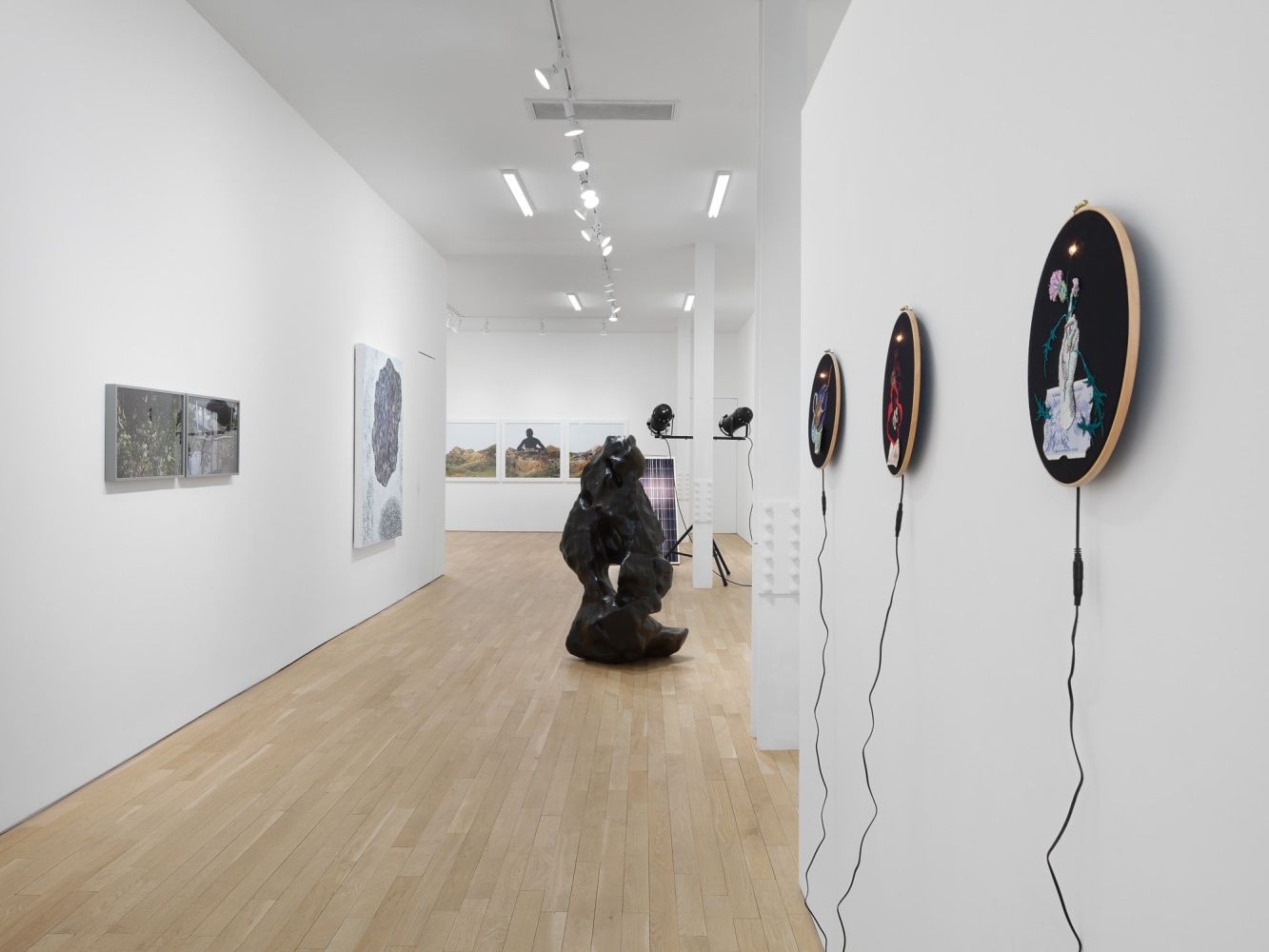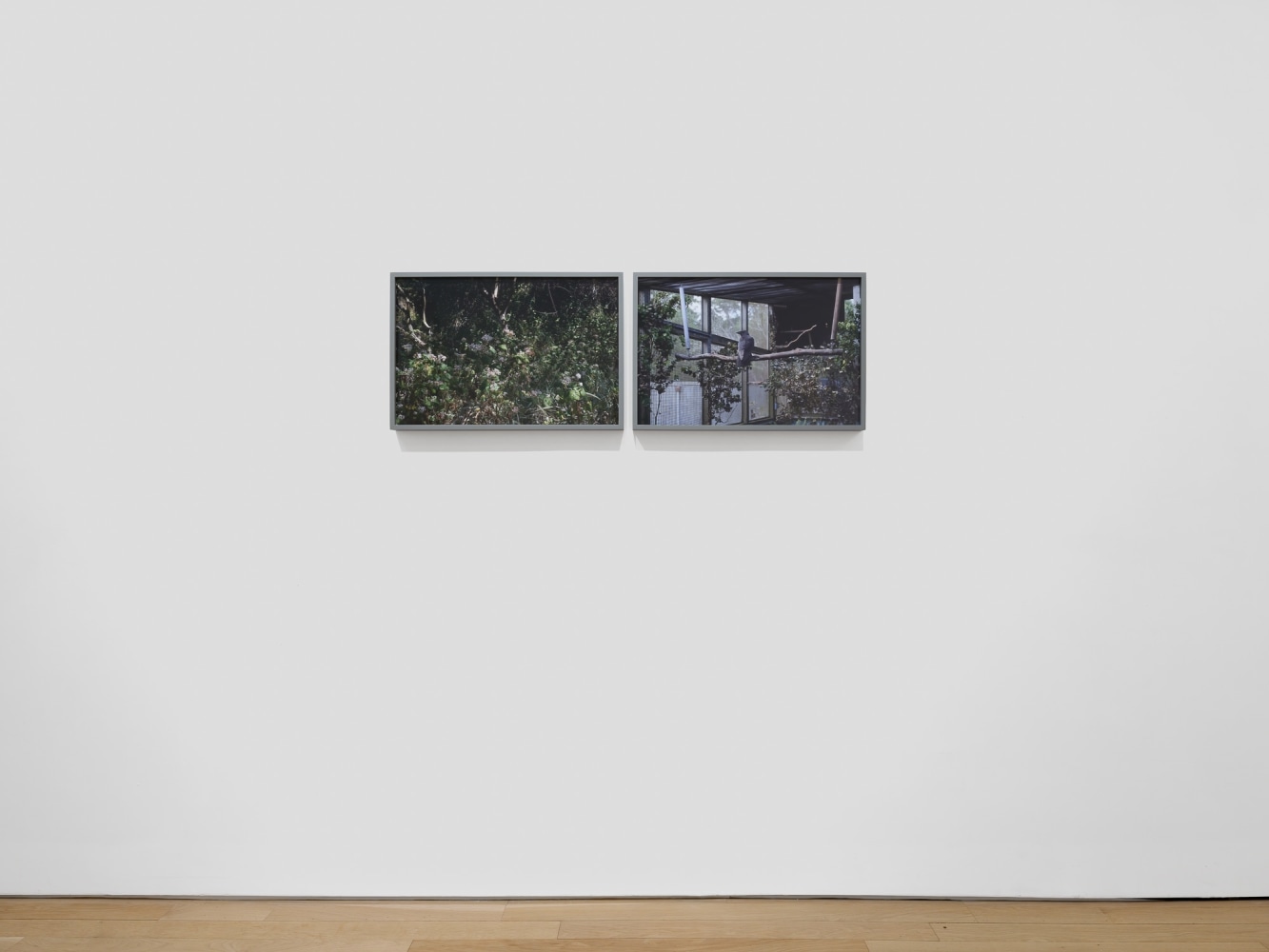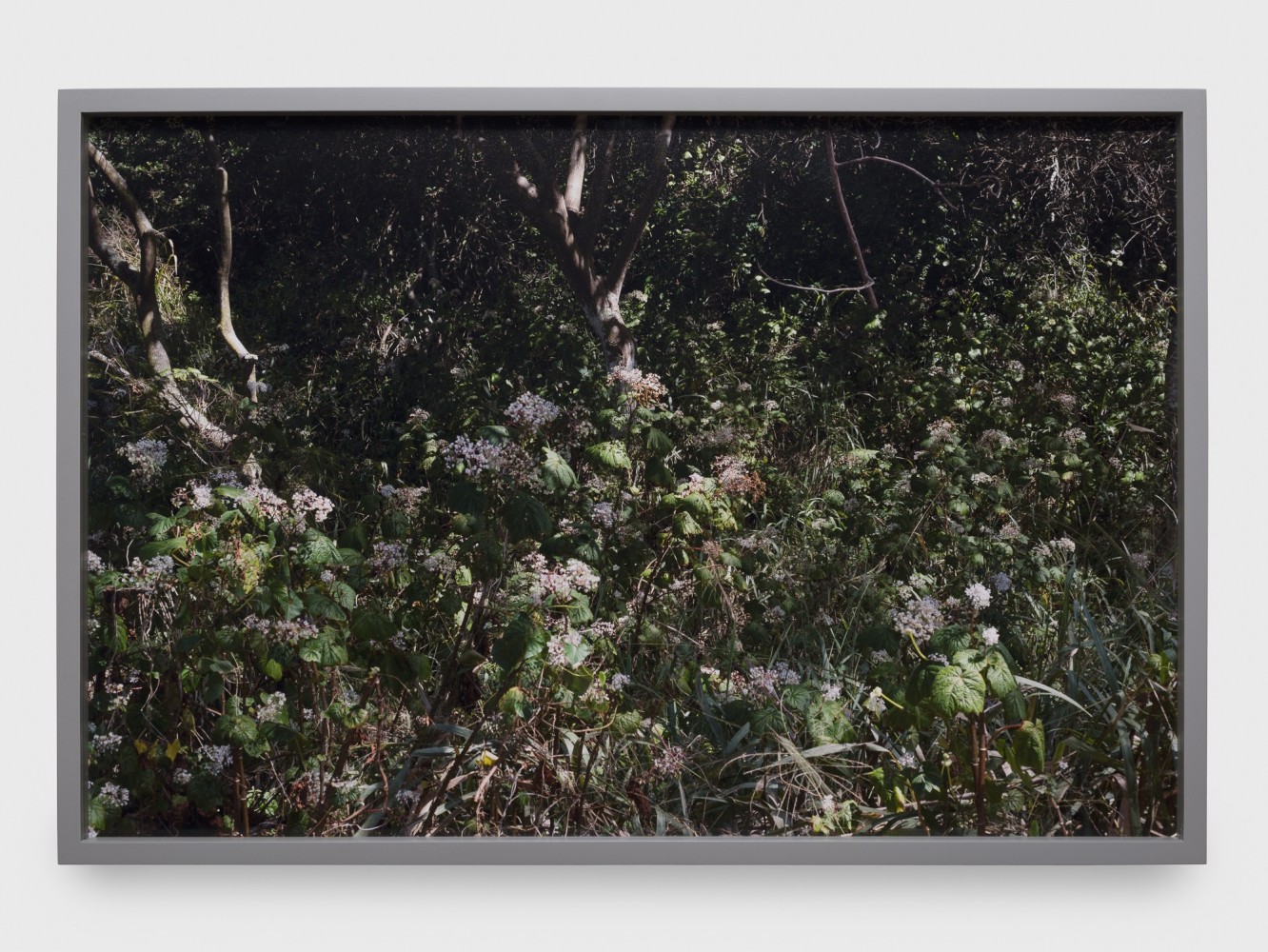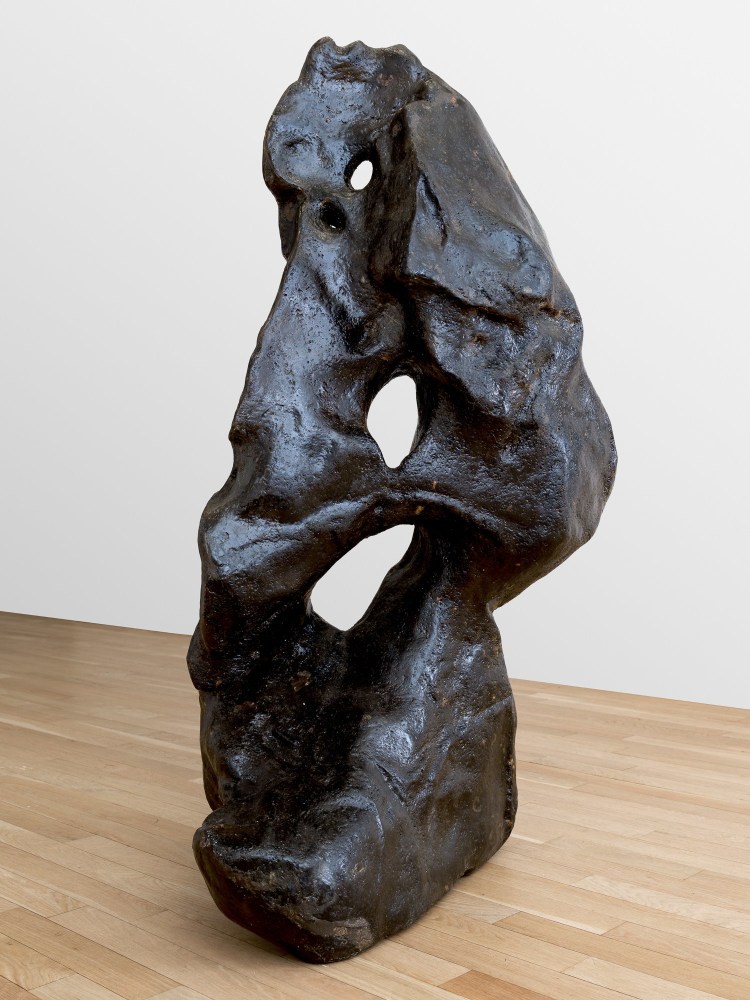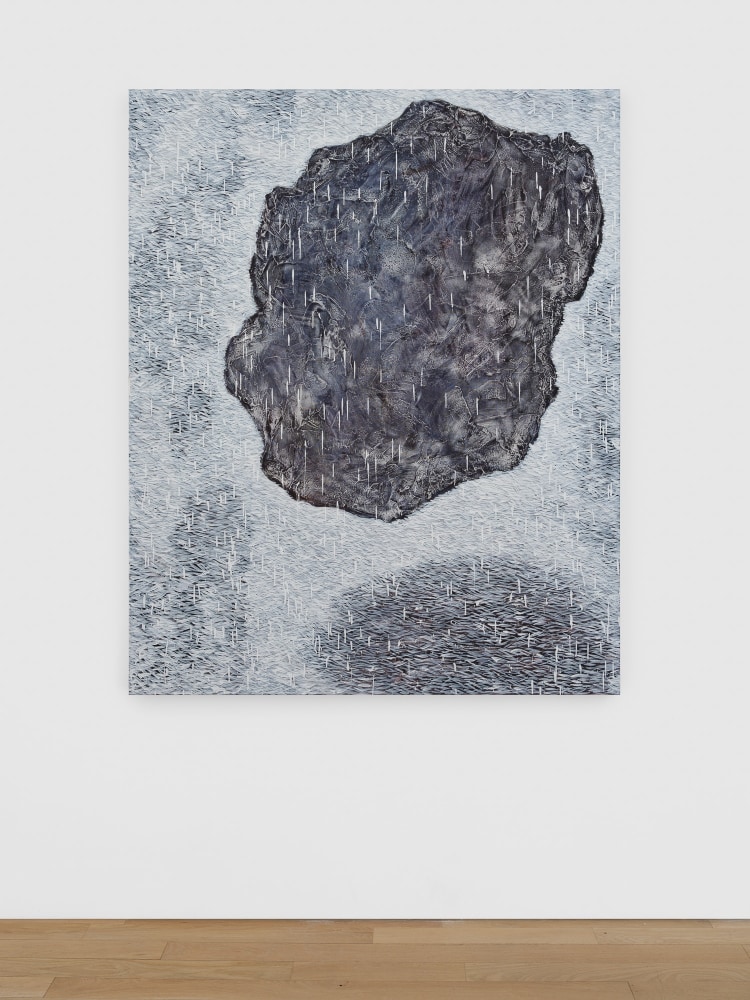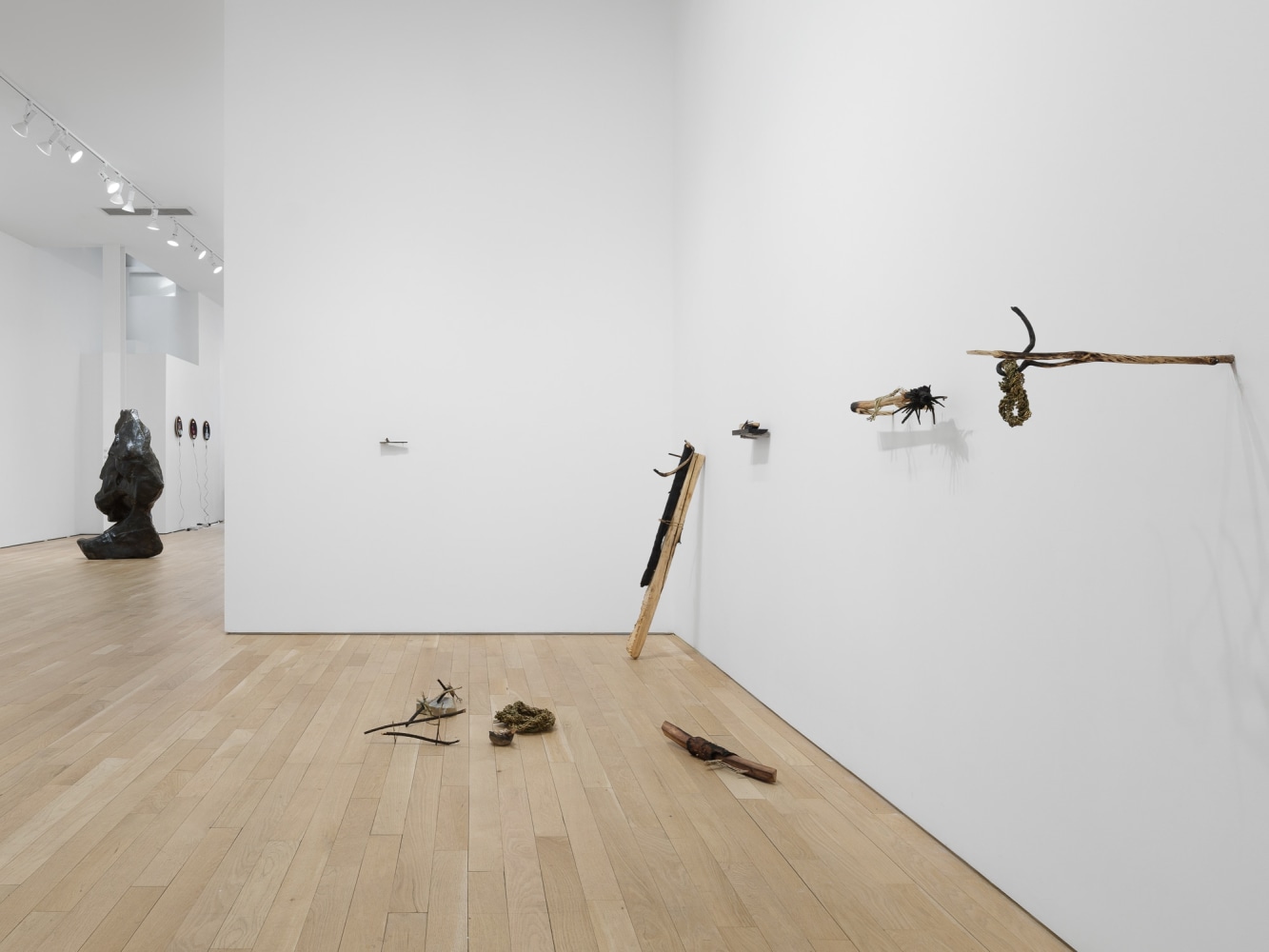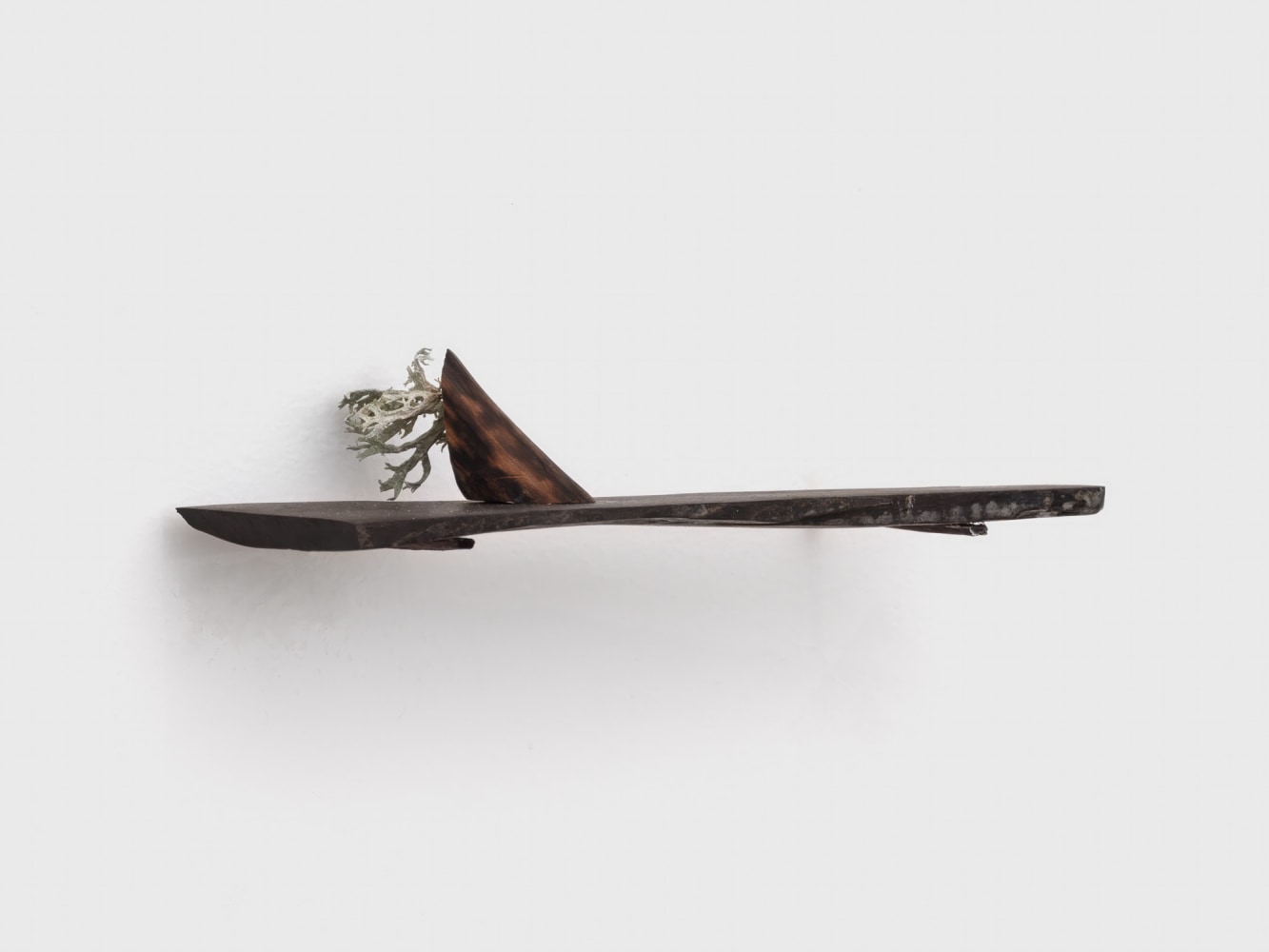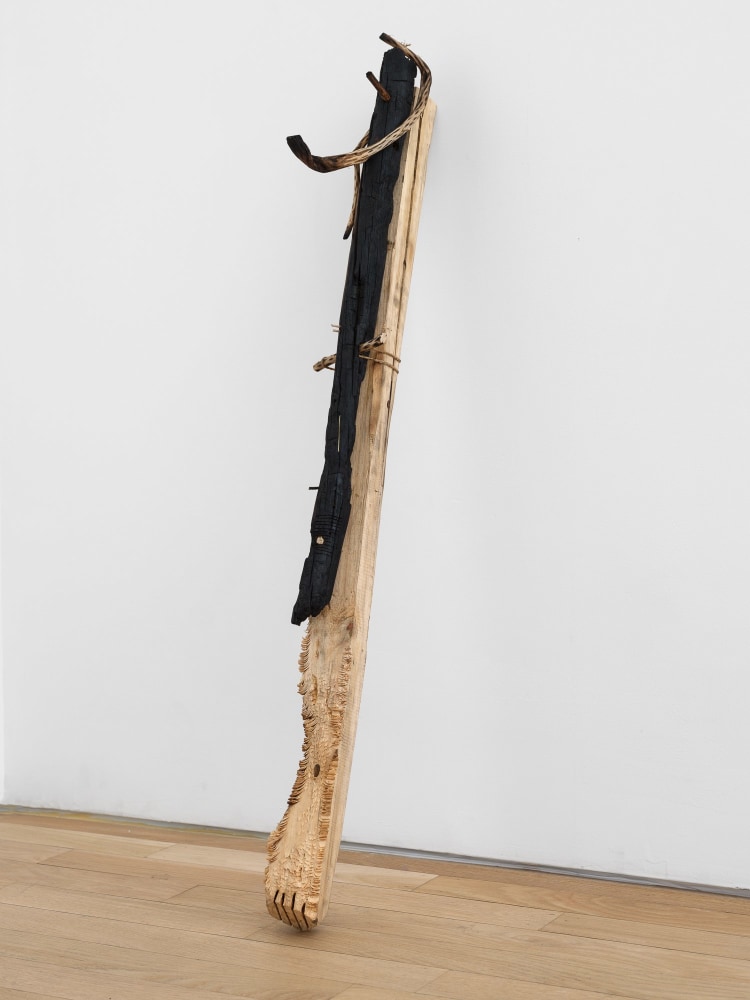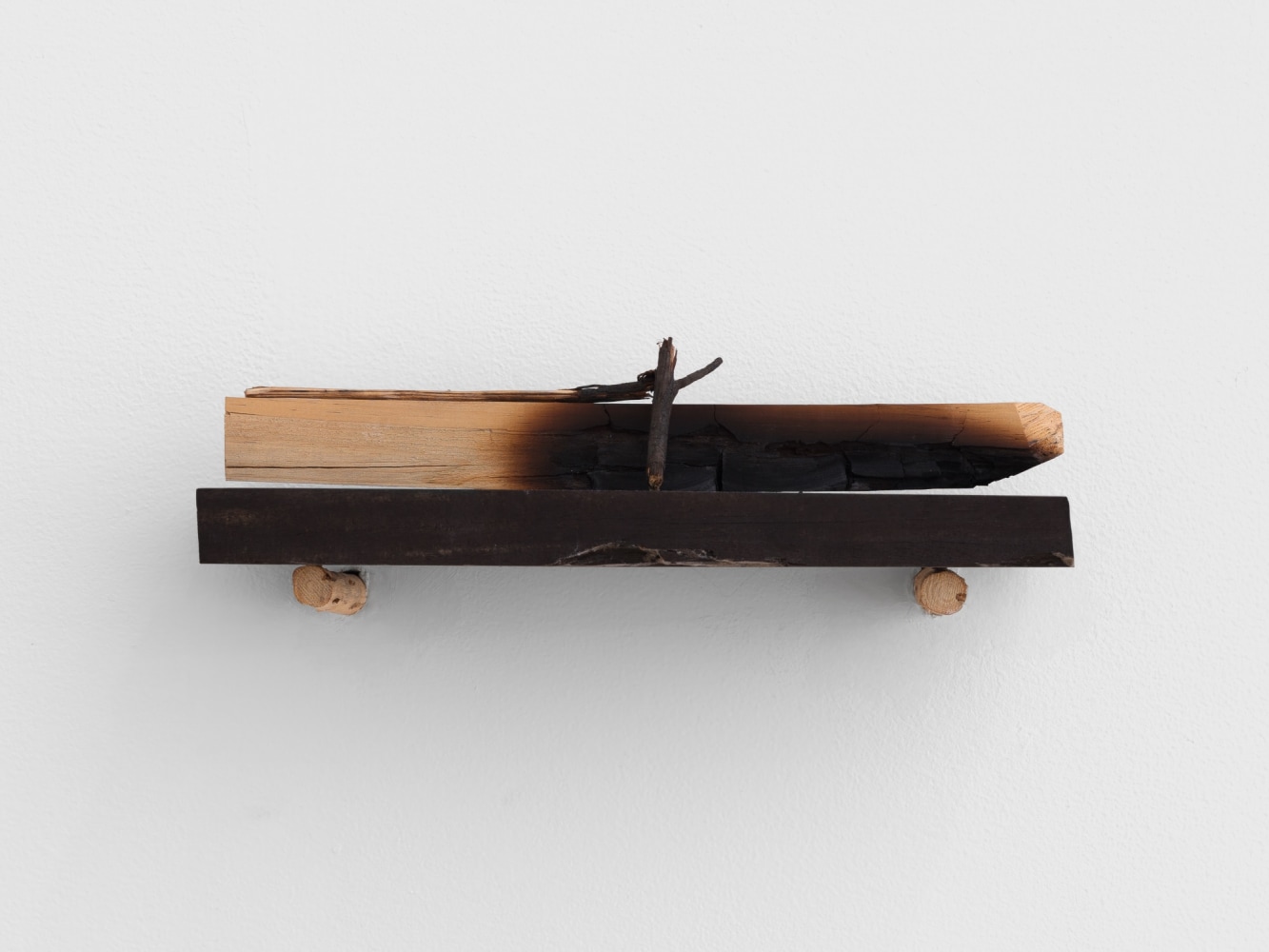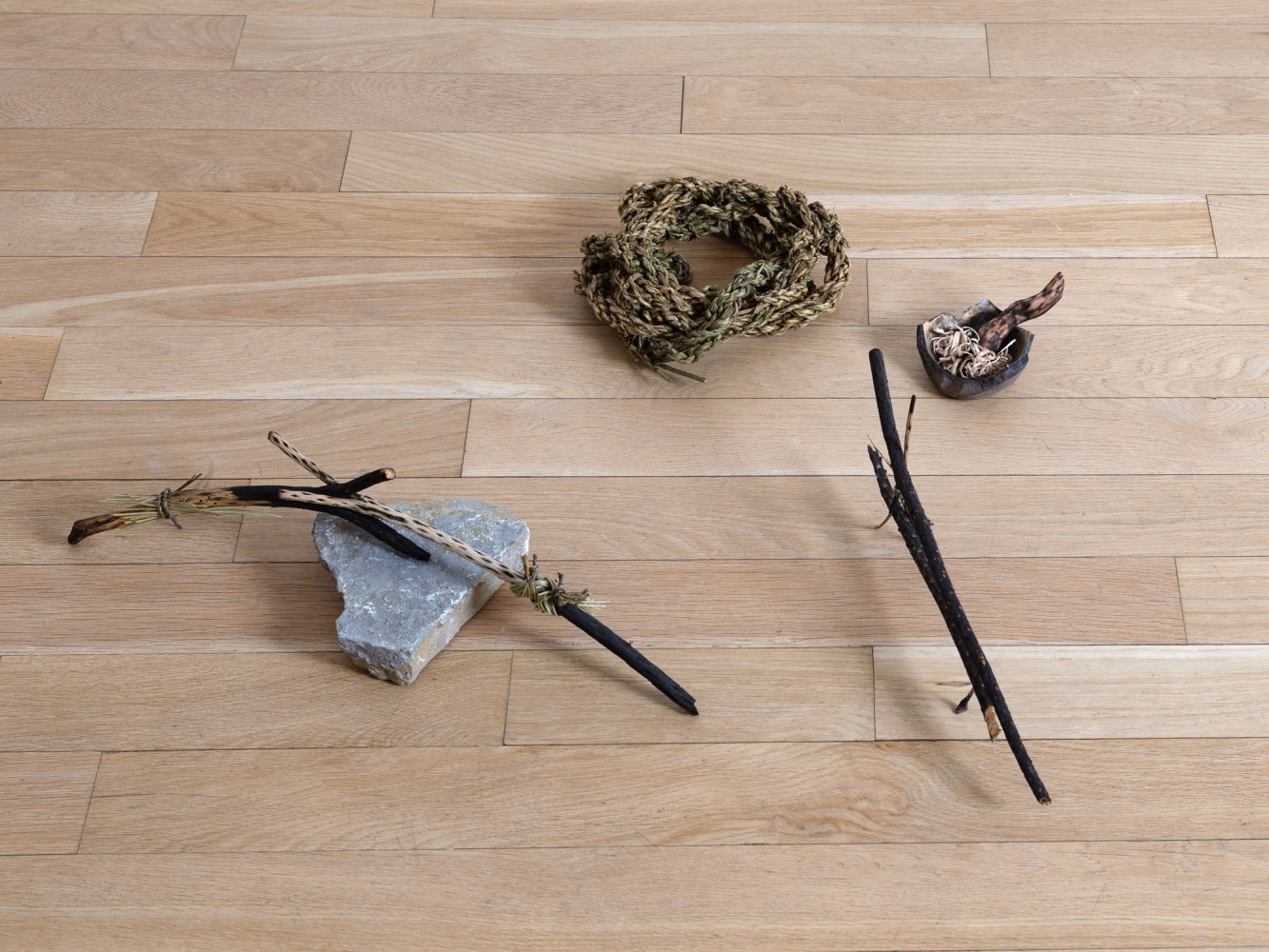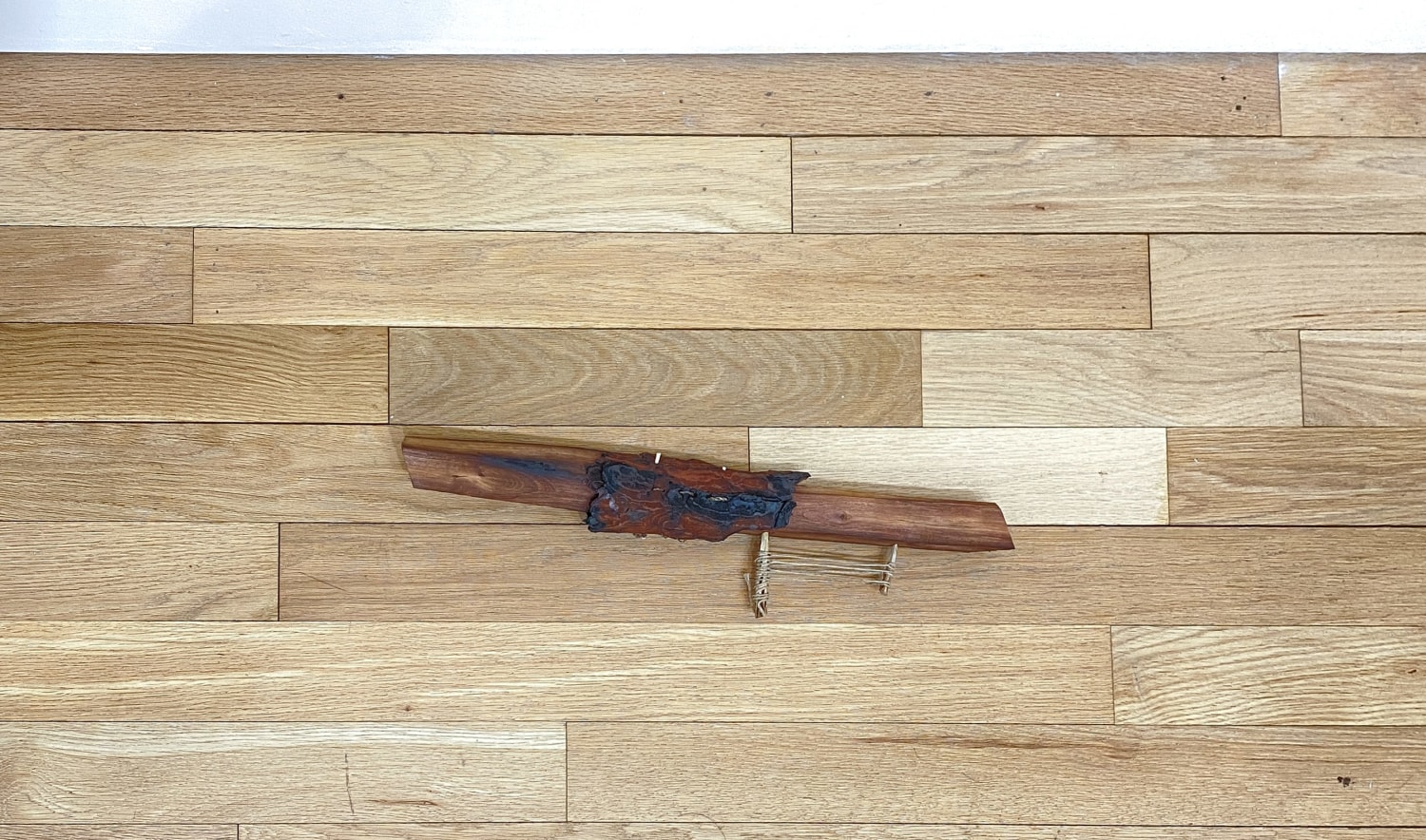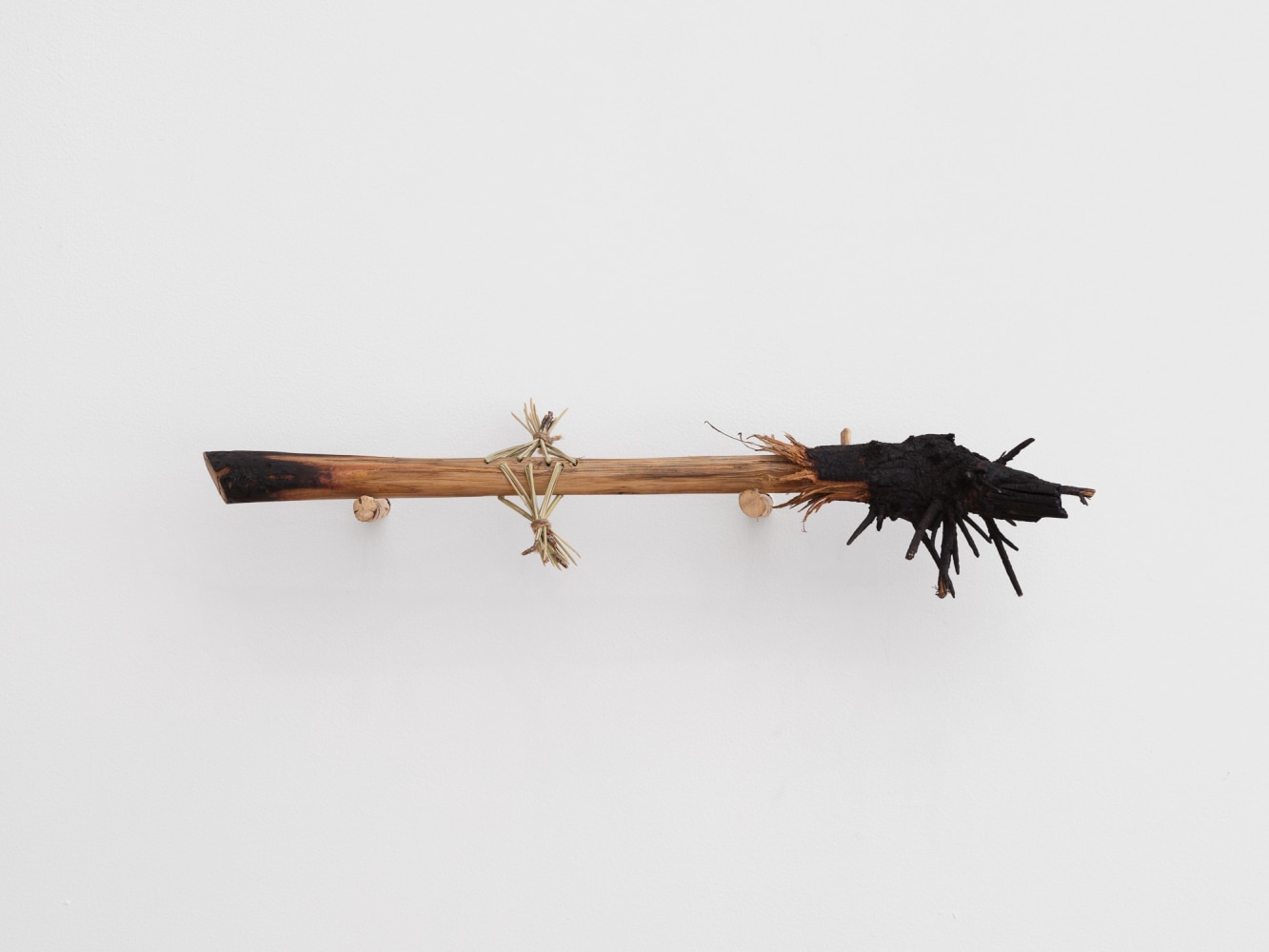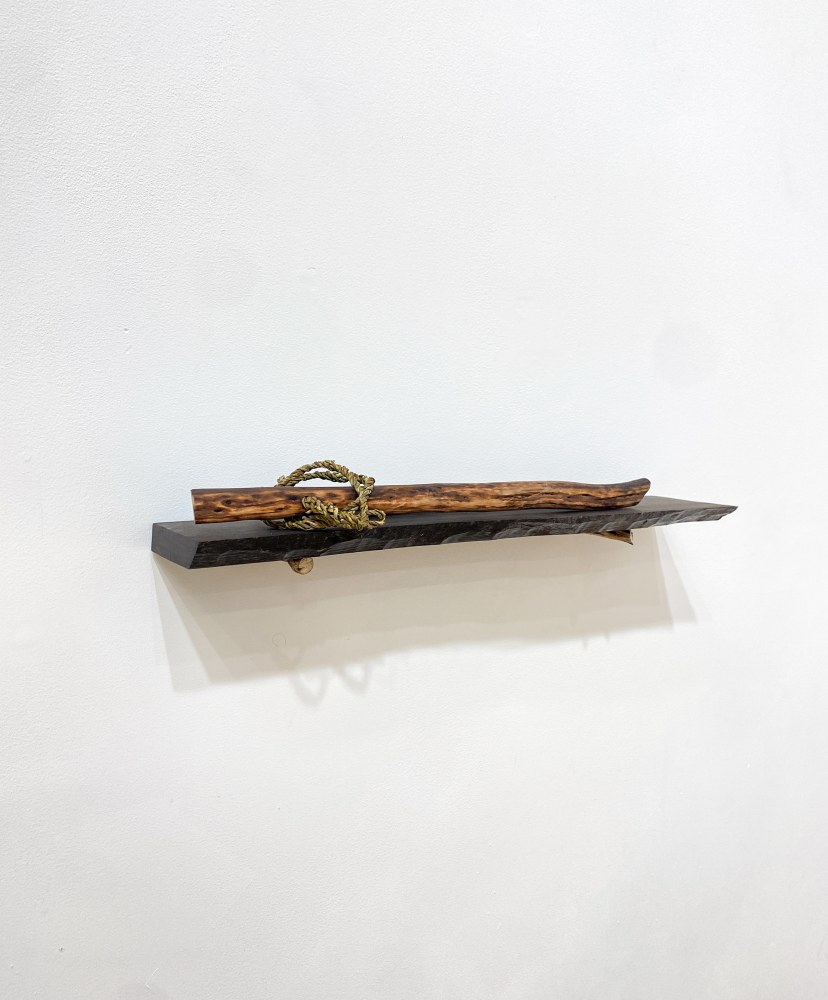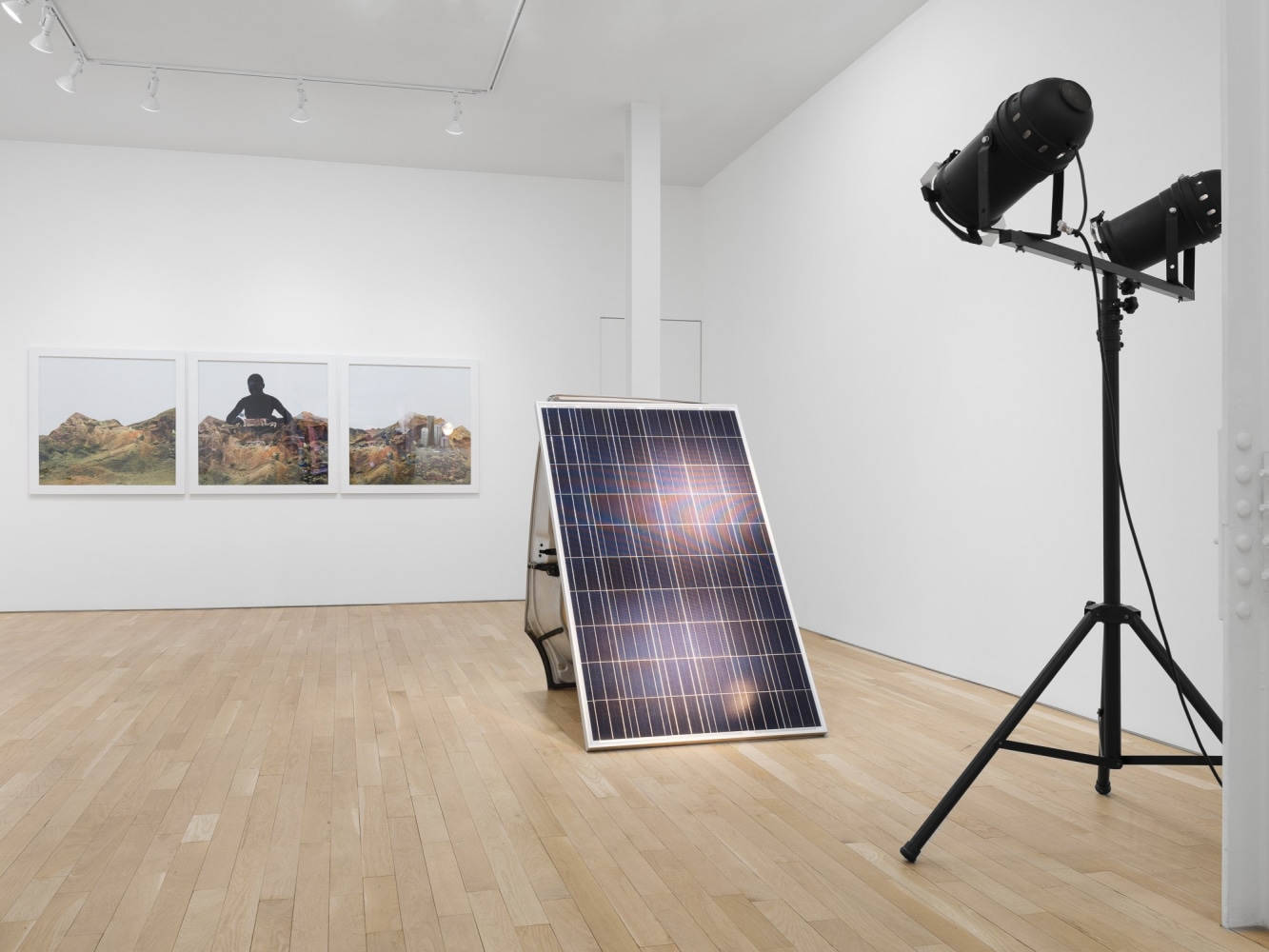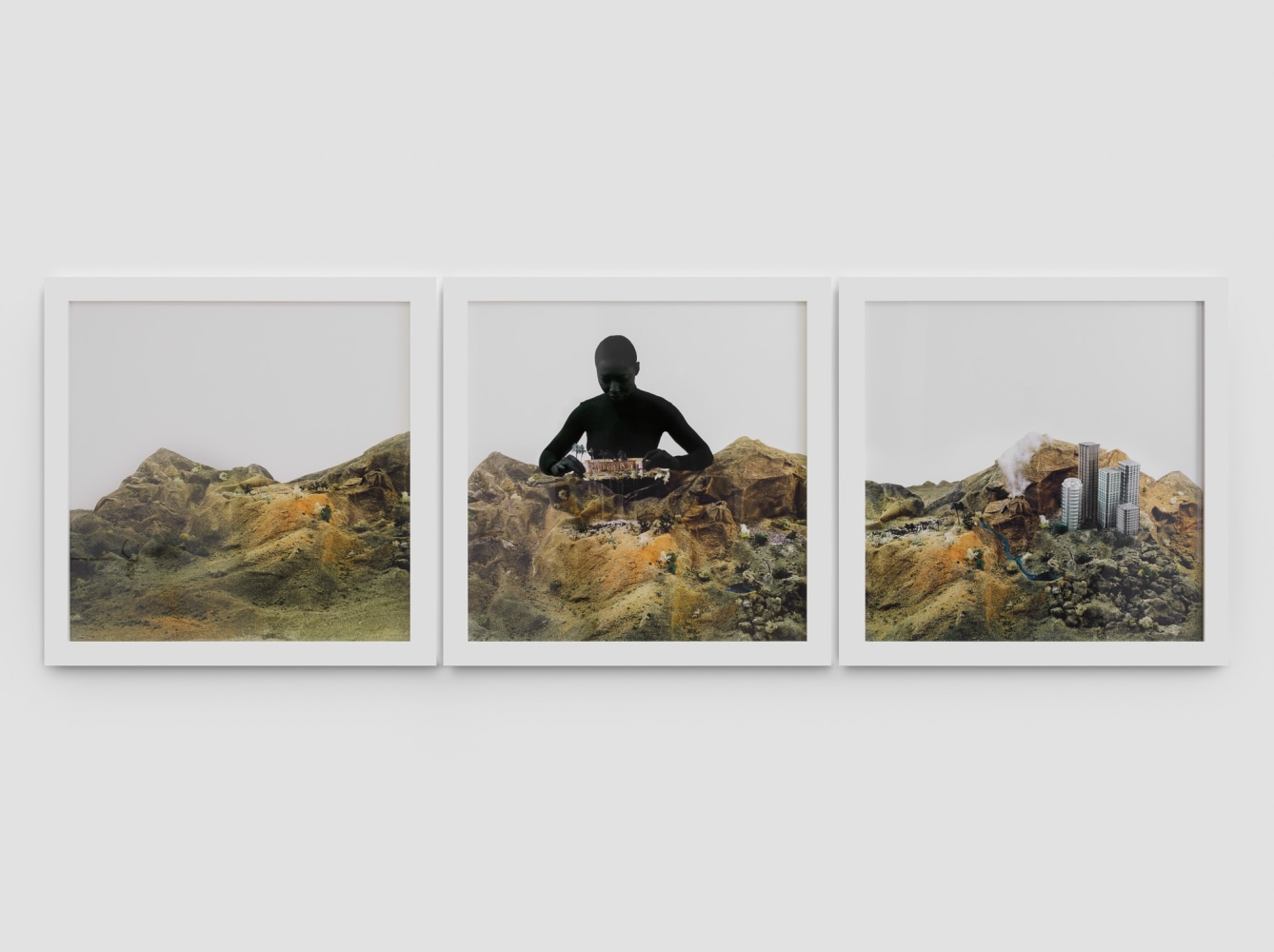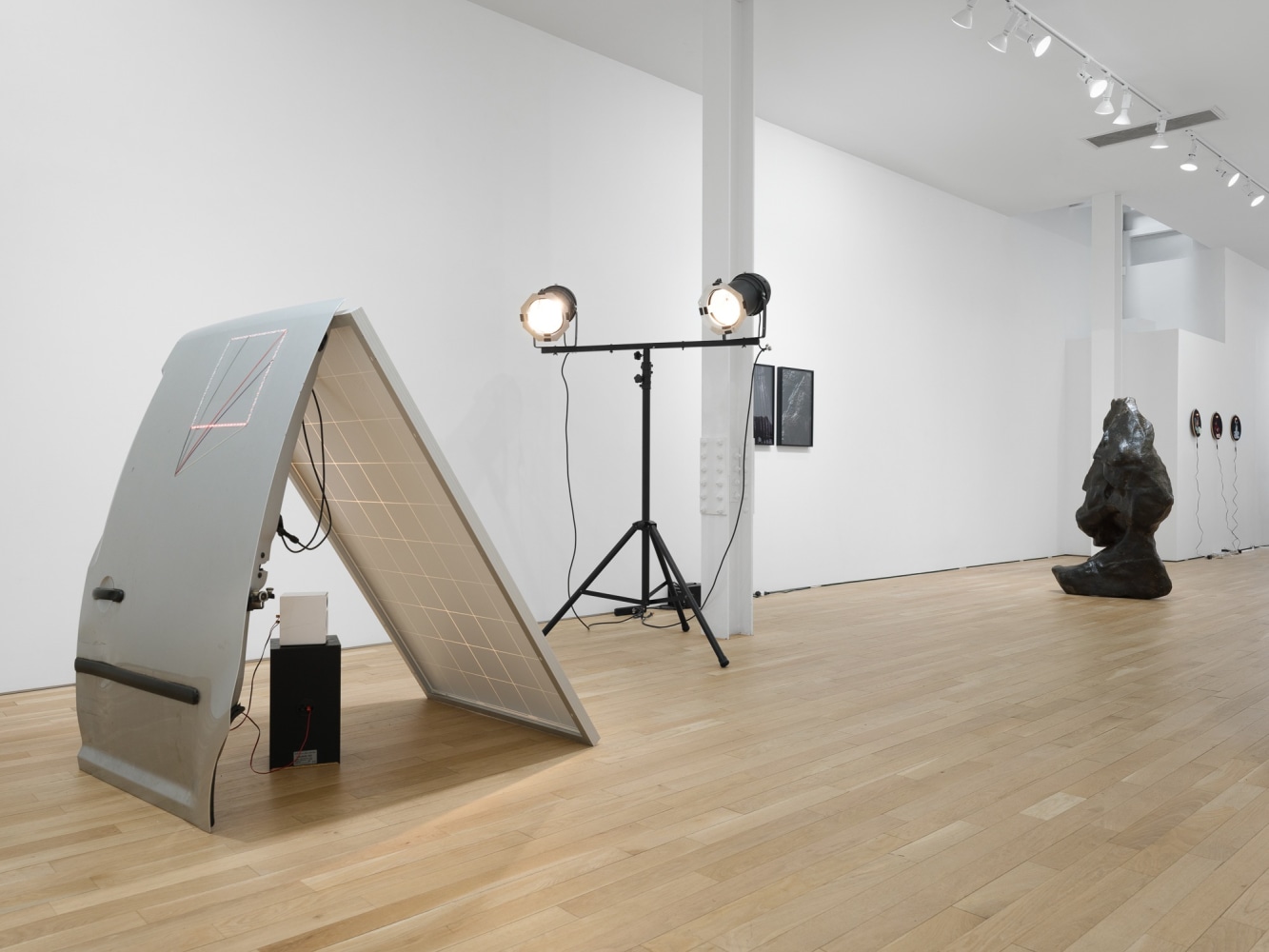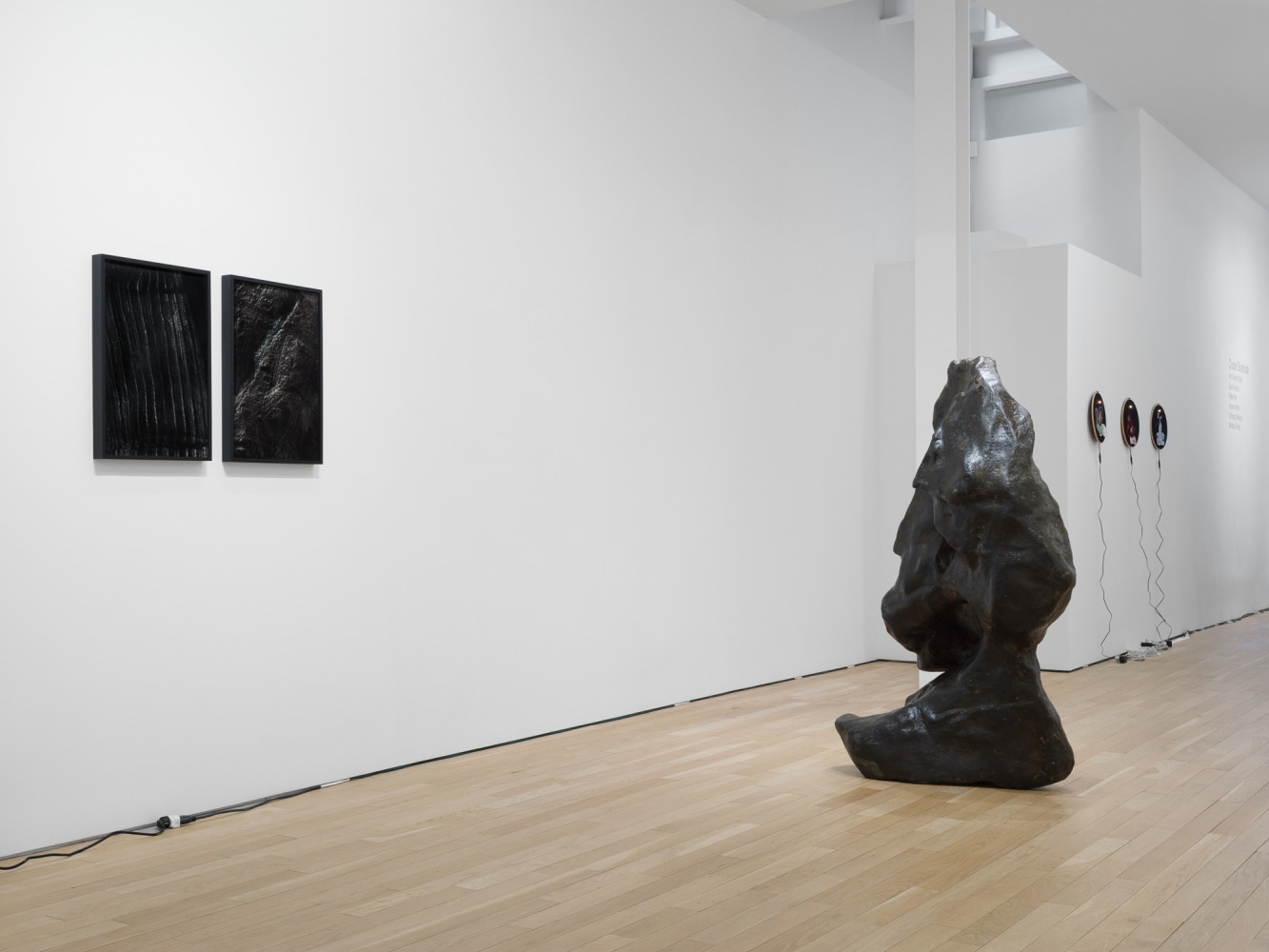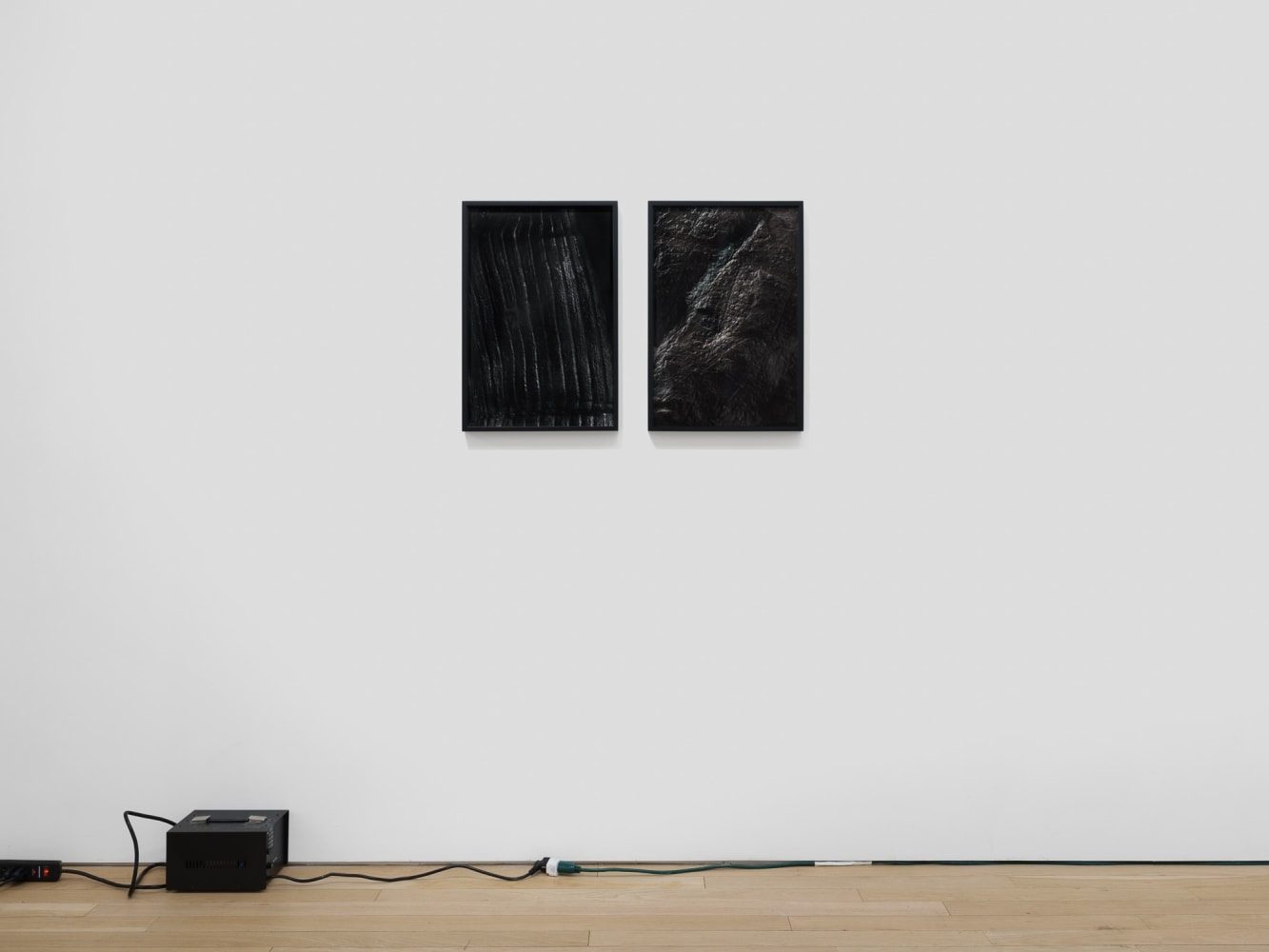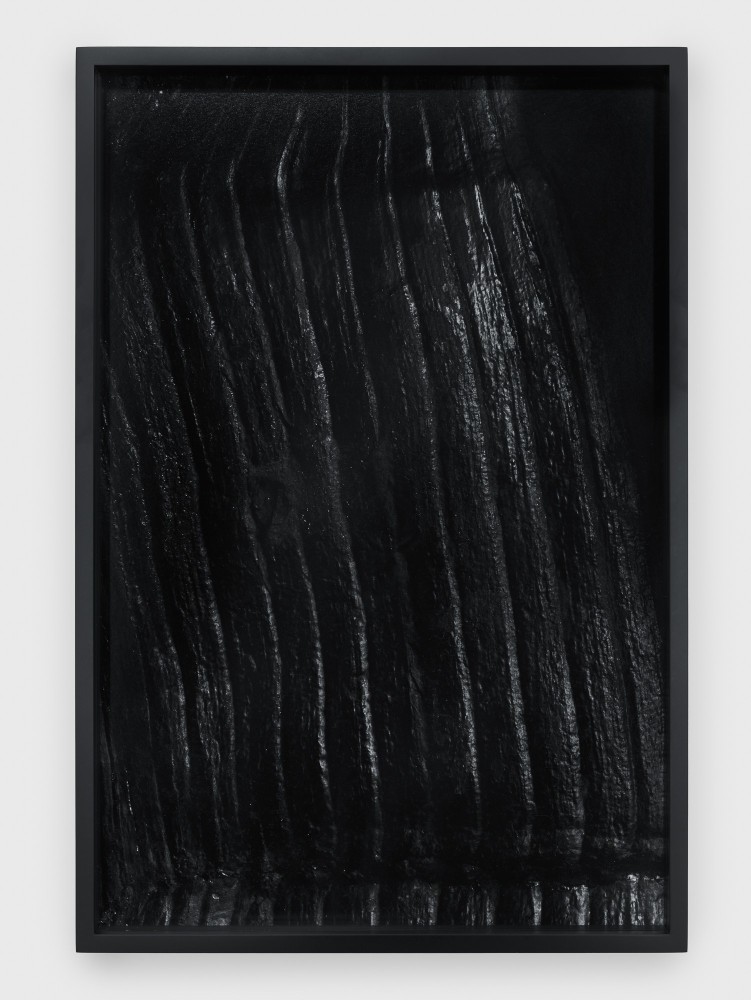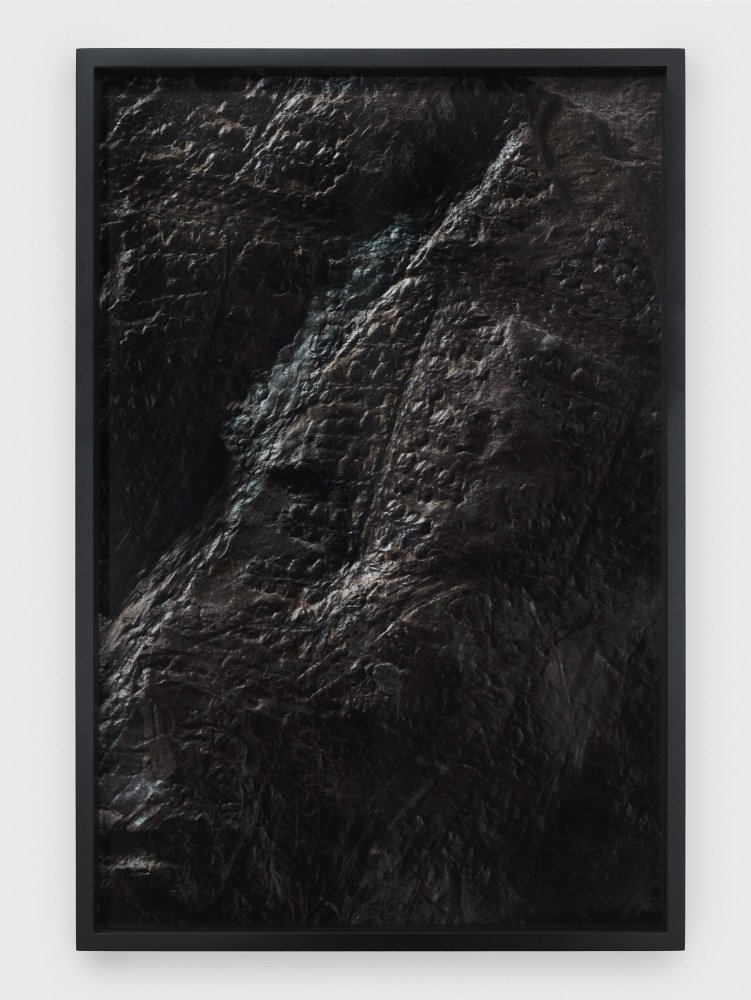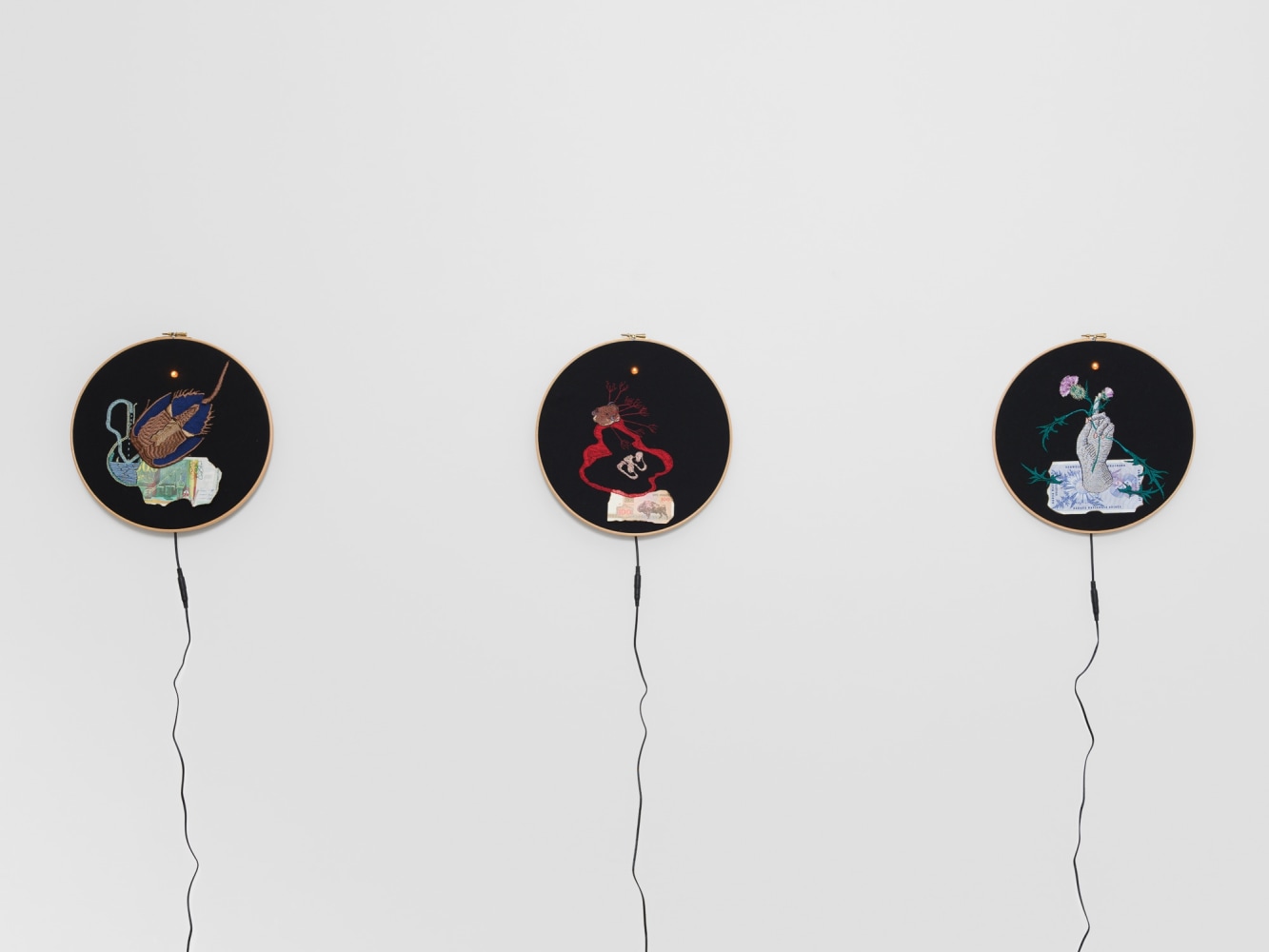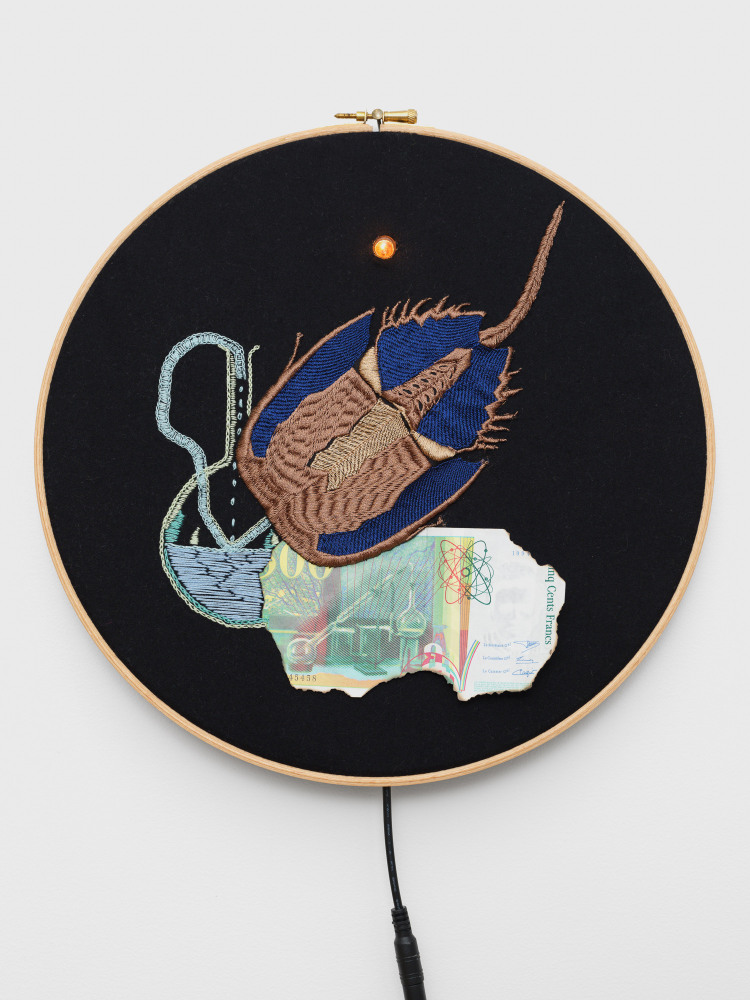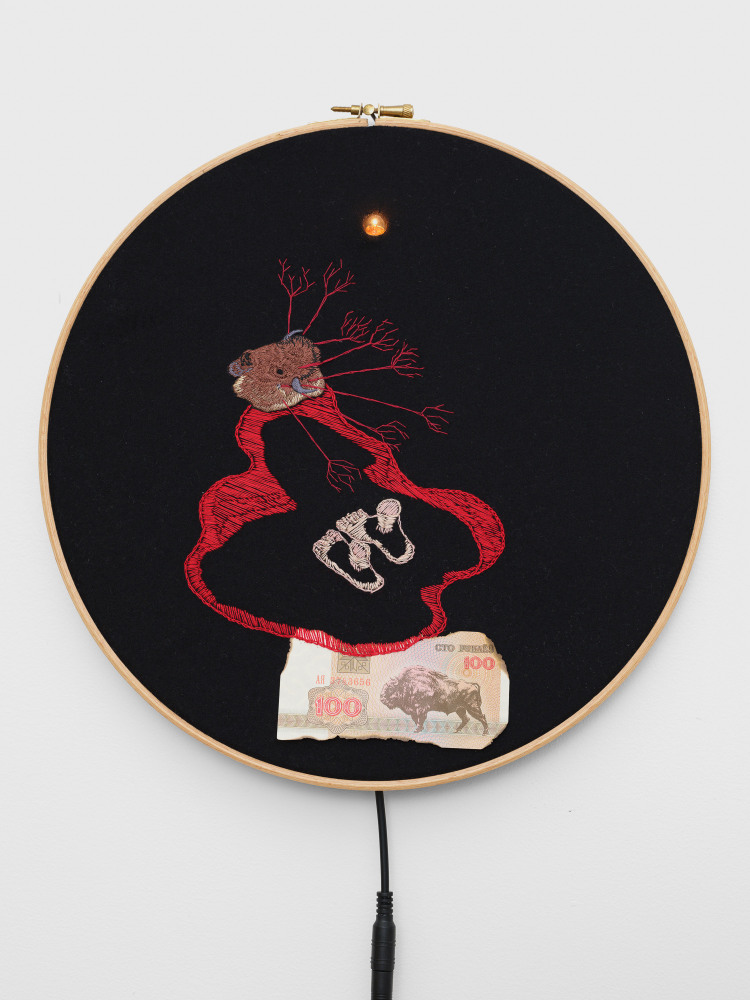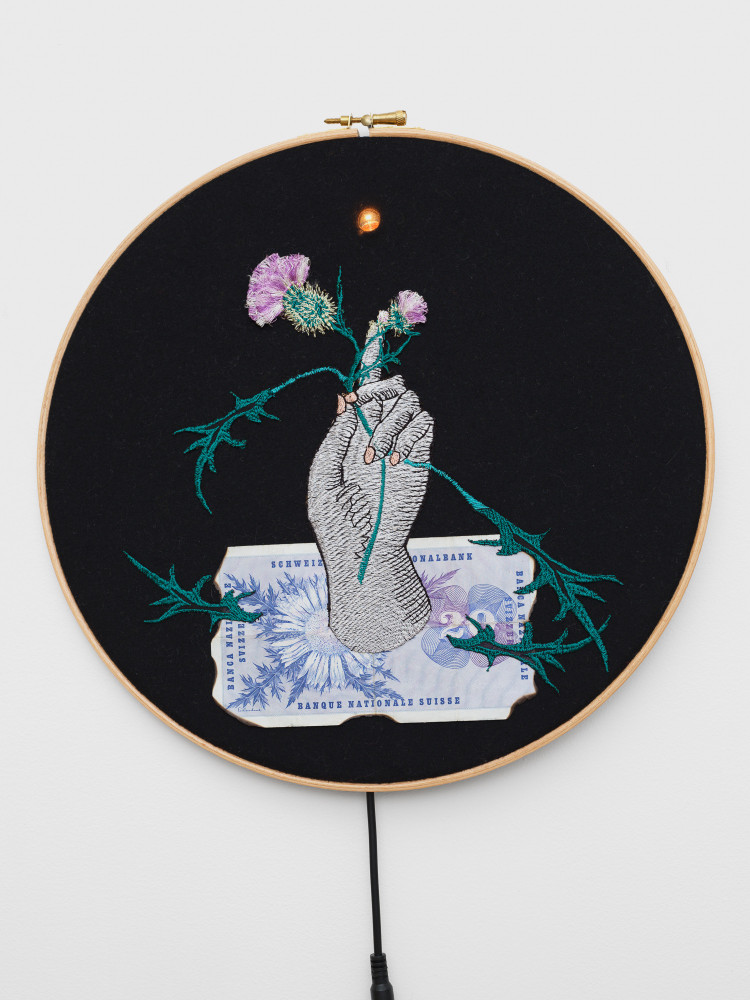Bienvenu Steinberg & J is pleased to present Crude Gratitude, an exhibition curated by Alice Audouin, a leading pioneer in the field of contemporary art and the environment in France and beyond. The exhibition features works by Art Orienté Objet, Sara Favriau, Peter Kim, Haroon Mirza, Otobong Nkanga, and Michael Wang.
Is gratitude a new trait of civilization? Extending towards the living and the cosmos, does it announce a more ecological civilization to come? Are contemporary environmental artists pioneering this new era? The exhibition explores this potentiality by bringing together six contemporary artists who adopt the praxis of care and promote interspecies collaboration. The artists in Crude Gratitude present an alternative lens to perceive the world, guided by attention towards each entity, whether on a microscopic or cosmic scale: an ecology of empathy.
Gratitude, a central tenet in most religions and philosophies, assumes a pivotal role. How might gratitude function as a tool in the realms of eco-psychology and art? Deployed as an antidote to the isolation pervading a world that was arrested by the Covid pandemic, gratitude emerges as a salient response. This emergence coincides with an increasing awareness of the fragility of human existence, amplified against the backdrop of climate change, international armed conflicts, and the alarming decline in biodiversity. The artists featured in Crude Gratitude embody a 'world mentality,' a transformative attitude defined by Edouard Glissant, as an alternative to globalization, a reorientation away from the confines of human-centrism, where humans take responsibility as active participants in a larger system.
Otobong Nkanga places care at the heart of her practice to draw clear paths of resilience in an overexploited world. In Alterscape Stories: Uprooting the Past (2006 - 2016), created during a residency in the Canary Islands, the artist reconstitutes a landscape traversed by time. Here, she portrays herself in the present, framed by a distant past that embodies undamaged nature and a future of destruction replete with natural disasters. The artist exhumes the shrouded parts of human history.
Using solar energy both as a sculptural element and as a source of light and sound, Haroon Mirza combines his practice with anthropology to craft a novel mythological and symbiotic relationship with the sun, for which he imagines new rituals. In this work, born of a conversation with English choreographer Wayne McGregor, a van door and solar panel lean against each other, creating a canopy, a sound space.
For 30 years, Art Orienté Objet has been harnessing shamanic forces as a healing tool for humans and the natural world. This French duo, pioneers in associating art, ecology, and ethology, created three apotropaic drums for the exhibition, awake, charged, and alive. They express their gratitude to environmental activists and whistleblowers, including leading figure Greta Thunberg. Additionally, they pay homage to Aby Warburg, a harbinger of the present ecological crisis, in a video translated into English for the first time.
Michael Wang adjusts the lens of the human gaze and consciousness to the scale of global issues. He brings focus to three major themes in his work: firstly, the ethics of interspecies relations, based on his research into the IUCN's Extinct in the Wild list; secondly, the environmental transformations of major landscapes and natural sites by disrupting the sculptural vocabulary of Lake Tai (China) with proliferating algae; and thirdly, the roots of the carbon-based world responsible for changing the climate, in the form of a tribute to its plant origins and the prodigals of photosynthesis.
Repriser le feu #2 is a site-specific installation created for the exhibition by French artist Sara Favriau. The artist selected and sculpted the scorched remnants left by the megafire that swept through the Landes forest in France in 2022; then, she waited for the first thorn bushes to weave a braid as a new symbolic narrative connecting humanity and its surroundings.
Peter Kim, drawing inspiration from the ocean, channels the oceanic feeling denied to him in his youth under the dictatorial regime in place at the time in South Korea. Through the deliberate slowness of his practice, the sobriety of his colors, and the meticulous attention paid to nature and memory, the artist seeks a way of being in the world that is as fair and light as possible. He reminds us that nothing can be owned, and that everything only truly exists through a revelation.
For further information and press inquiries, please contact Christophe Choi (christophe@bsandj.com).
FR Text:
La gratitude est-elle un nouveau trait de civilisation ? Élargie à la vie sur terre et au cosmos, annonce-t-elle une civilisation plus écologique à venir? Les artistes contemporains liés à l'environnement en sont-ils les pionniers ?
La commissaire d’exposition Alice Audouin, pionnière française du lien entre art et environnement, explore cette hypothèse en conviant des artistes contemporains engagés dans la pratique du care, la collaboration avec d’autres espèces et l'amour de l’invisible, qu’il soit microscopique ou cosmique. Ces artistes invitent à une autre conscience du monde, où l'écologie naît de l'empathie.
Selon l’artiste Haroon Mirza, le passage des énergies fossiles à l’énergie solaire conduirait à l’émergence d’une gratitude vis-à-vis du cosmos et une prochaine « civilisation solaire » pourrait bien être meilleure que la nôtre.
La gratitude est présente dans la plupart des religions et déploie aujourd’hui sa force positive dans les champs de la philosophie, l’éco-psychologie ainsi que de l’art. Re-investie comme un antidote à l’isolement et à un monde délité pendant la pandémie du Covid (en témoigne l’action de Marina Abramovic), elle se déploie à mesure que l’humain prend conscience de la fragilité de ses propres conditions d’existence, bouleversées par le réchauffement climatique ou la chute de la biodiversité.
Une gratitude « primordiale » au monde, étendue à l’air, à l’eau, à la terre, aux morts, au cosmos, aux espèces animales et végétales, aux bactéries, à la diversité des mondes, à la culture, et non plus seulement aux personnes est en marche.
Les six artistes de l’exposition « Crude Gratitude » conçoivent cette nouvelle relation au monde dans une « mondialité » chère à Edouard Glissant. Pour eux, la gratitude est une lecture du monde fondée sur l'interdépendance et conduit à la responsabilité.
Porteuse d’une conscience aiguë des enjeux à la fois écologiques, sociaux et géopolitiques, Otobong Nkanga, place le care au coeur de sa pratique pour dessiner des voies de résilience dans un monde surexploité. Dans cette oeuvre fondatrice de sa pratique née d’une résidence aux Iles Canaries, elle reconstitue un paysage traversé par le temps. Elle se met ici en scène au présent, encadrée par un lointain passé incarnant une nature intacte et un futur à la fois destructeur et menacé par des forces naturelles. L’artiste exhume la part cachée de l’histoire humaine, seule condition pour relier ces trois temporalités.
Haroon Mirza utilise l’énergie solaire à la fois comme élément sculptural et comme alimentation d’éléments sonores et lumineux. Il allie sa pratique et l’anthropologie pour penser une nouvelle relation mythologique et empathique avec le soleil, dont il imagine de nouveaux rituels. Ici, l’adossement d’une porte d’un van et d’un panneau solaire forme une voûte qui surplombe un espace sonore, annonciateur d’une nouvelle ère. Cette pièce est née d’un dialogue avec le chorégraphe anglais Wayne McGregor.
Depuis 30 ans, Art Orienté Objet active les forces chamaniques pour la guérison des êtres humains et de la biodiversité. Ce duo français formé il y a trente ans et pionnier du lien entre l’art, l’écologie et l’éthologie, a créé pour l’exposition trois tambours apotropaïques, « signifiants, chargés et vivants ». Il exprime sa gratitude vis-à-vis des activistes environnementaux et lanceurs d’alerte, dont la figure majeure de Greta Thunberg. Leur « Gretatude » s’étend à Aby Warburg qui fut prescient de la crise écologique actuelle, à qui ils rendent hommage dans une vidéo pour la première traduite en anglais.
Le jeune artiste new-yorkais Michael Wang ajuste le regard et la conscience humaine à l’échelle des enjeux globaux. Il révèle ici trois thèmes majeurs de son travail, d’abord l’éthique de la relation inter-espèces, à travers sa recherche sur la liste Extinct in the Wild de l’IUCN, puis les transformations environnementales des grands paysages et sites naturels, en bousculant le vocabulaire sculptural du Lac Tai (Chine) par des algues prolifères, et enfin les racines du monde carboné qui modifie le climat, sous la forme d’un tribut à son origine végétale et aux prodigues de la photosynthèse.
Repriser le feu #2 est une installation spécifiquement conçue et installée pour l'exposition par la jeune artiste française Sara Favriau, dont les sculptures en bois témoignent d'une approche socio-écologique engagée. L’artiste a sélectionné puis sculpté les vestiges calcinés du mégafeu de la forêt des Landes (France) de 2022 puis a attendu la venue des ronces, gestantes d’un nouveau cycle, pour tresser une corde, telle la trame d’un récit réparateur entre l’humain et son environnement.
Peter Kim a puisé dans l’océan le « sentiment océanique » qui manquait à sa jeunesse privée d’expression libre dans son pays, la Corée du Sud, alors soumis à un régime dictatorial. Sa pratique est traversée par une recherche d’économie de moyens et une lenteur volontaire. Par le dessin, une utilisation décroissante de la couleur, l’attention portée à la nature et à la mémoire, l’artiste cisèle une façon d’être au monde la plus juste et légère possible. Il rappelle que rien ne se possède et que tout n’existe vraiment que dans une révélation.
En cette période de conflits, d’économie désincarnée, de solitude, de réchauffement climatique et d’effondrement de la biodiversité, aggravée par un nouvel épisode El Nino, la gratitude fait rempart, maintient la joie d’être au monde.
Pour plus d'informations et les demandes de presse, veuillez contacter Christophe Choi (christophe@bsandj.com)


